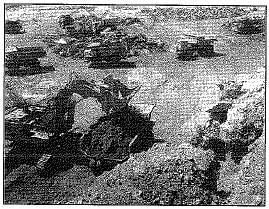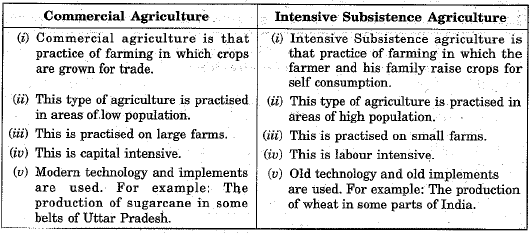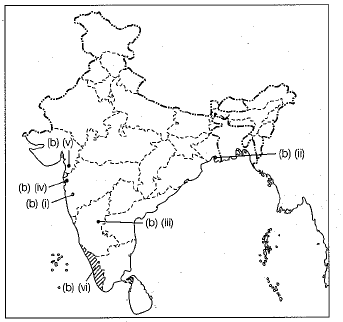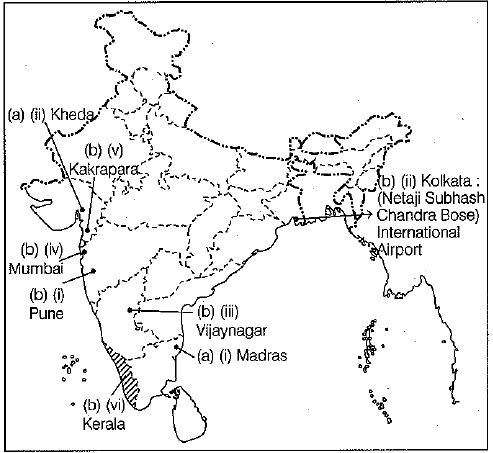Class 10 Social Science: CBSE Sample Question Paper (2019-20) - 5 | Social Studies (SST) Class 10 PDF Download
SOCIAL SCIENCE (CODE 087)
CLASS X – SESSION 2019-20
SAMPLE QUESTION PAPER
Time Allowed: 3 Hours
Maximum Marks: 80
General Instructions:
i. The question paper has 35 questions in all.
ii. Marks are indicated against each question.
iii. Questions from serial number 1 to 20 are objective type questions. Each question carries one mark. Answer them as instructed.
iv. Questions from serial number 21 to 28 are 3 marks questions. Answer of these questions should not exceed 80 words each.
v. Questions from serial number 29 to 34 are 5 marks questions. Answer of these questions should not exceed 120 words each.
vi. Question number 35 is a map question of 6 marks with two parts - 35 a. from History (2 marks) and 35b. from Geography (4 marks).
SECTION – A VERY SHORT ANS. QUESTIONS
Q.1. What is the percentage of the Sinhala speaking population in Sri Lanka ? (1 Mark)
(a) About 74%
(b) Almost 50%
(c) Less than 27%
(d) Less than 19%
Ans: (a)
Q.2. State the main characteristic of commercial farming. (1 Mark)
Ans: Use of higher doses of modem inputs i.e., HYV seeds, chemical fertilisers, insecticides and pesticides in order to obtain higher productivity.
Or
What is Minimum Support Price of a crop ? (1 Mark)
Ans: Minimum Support Price is the price at which FCI procures food grains from the farmers.
Q.3. Which one of the following institutions was established in the Bretton Wood Conference ? (1 Mark)
(a) International Security Fund
(b) International Monetary Fund
(c) Indian Monetary Fund
(d) International Labour Organisation
Or
Why did the women working in the woollen textile industry begin attacking the Spinning Jenny ? (1 Mark)
(а) It caused them unemployment
(b) They could not operate the machine
(c) It did not produce finer yarn
(d) They w ere scared o f the machine
Ans: (b) Or (a)
Q.4. Trace the reason because of which Gandhiji started satyagraha in 1919. (1 Mark)
Ans: To protest against the Rowlatt Act.
Q.5. Which was world's first mass produced car?
Or
Who discovered America? (1 Mark)
Ans: T-Model Ford was the world's first mass produced car.
Or
Christopher Columbus discovered America.
Q.6. Where most of the jute mills are located ? (1 Mark)
(a) Along the banks of the Hugh river.
(b) Near the Sunderbans Delta.
(c) Along the banks of Ganga river in Haridwar.
(d) Near Bay of Bengal.
Ans: (a)
Q.7. How can the resources be classified on the basis of their origin ? (1 Mark)
(a) Biotic and abiotic
(b) Renewable and non-renewable
(c) Individual and community
(d) Potential and reserves
Ans: (a)
Q.8. ___________language is spoken by majority of Sri LankAns:
OR
In a democracy, people rule themselves through institution of ________. (1 Mark)
Ans: Sinhala (X)
OR
self-government
Q.9. Veena works in an office. She attends her office from 9:30 am to 5:30 pm. She gets her salary regularly at the end of every month. In addition to the salary she also gets provident fund as per the rules laid down by the government. She also gets medical and other allowances. Veena does not go to office on Sundays. This is a paid holiday.
Analyse the above information and tell in which sector Veena is working? (1 Mark)
(a) Organised sector
(b) Unorganised sector
(c) Private sector
(d) None of these
Ans: (a)
Q.10. Which area of the world has the largest crude oil reserves ? (1 Mark)
(a) Middle east
(b) Far east
(c) South east
(d) North east
Ans: (a) Middle east
Q.11. ___________ types of roads are being constructed and maintained by National Authority of India. (1 Mark)
Ans: National Highways.
Q.12. Besides seeking more income, people also seek other things like: (1 Mark)
(a) Equal treatment
(b) Respect of others
(c) freedom and security
(d) All of the above
Ans: (d)
Q.13. Study the picture and answer the question that follows : (1 Mark)
Which of the following aspect best describes the activity shown in the picture?
(a) Mining activity
(b) Construction of building
(c) Construction of dams
(d) Parking lot
Ans: (a) Mining activity
Q.14. The National Jute Policy was formulated in the year ______. (1 Mark)
Ans: 2005
Q.15. ___________. type of government can reduce the possibility of tensions and conflict between different groups of society. (1 Mark)
Or
___________ aspect of democracy describes that it is a government run by the consent of the people.
Ans: Democratic Or Political
Q.16. Find the incorrect option: (1 Mark)
(a) A developed country has high per capita income
(b) A developed country has high HDI
(c) A developed country has high standard of living
(d) A developed country has low quality of life parameters
Ans: (d)
Q.17. Correct the following statement and rewrite it. (1 Mark)
The organised sector covers those enterprises or places of work where the terms of employment are not regular and people have less assured work.
Or
The unorganised sector is characterised by small and scattered units which are largely inside the control of government and governmental rules and regulations are strictly followed.
Ans: The organised sector covers those enterprises or places of work where the terms of employment are regular and people have assured work.
Or
The unorganised sector is characterised by small and scattered units which are largely outside the control of government and governmental rules and regulations are not strictly followed
Q.18. Workers in the__________sector do not produce goods. (1 Mark)
Ans: tertiary.
Q.19. Documentation requirement, mode of payment and interest rates together is called a s __________ . (1 Mark)
Ans: Terms of credit.
Q.20. Mahesh is a small farmer. He has taken a loan of  lakhs from the money leader to meet the expenses of cultivation. The annual interest rate on the loan is very high, so he is unable to repay the loan and he is a caught in debt. He has to sell a part of the land to pay off the debt.
lakhs from the money leader to meet the expenses of cultivation. The annual interest rate on the loan is very high, so he is unable to repay the loan and he is a caught in debt. He has to sell a part of the land to pay off the debt.
Analyse the loan information given above, considering one of the following correct option: (1 Mark)
(a) Terms of credit
(b) Interest on loan
(c) Debt-trap
(d) Mode of repayment
Ans: (c)
SECTION – B SHORT ANSWER QUESTIONS
Q.21. Read the sources given below and answer the questions that follows: (3 Mark)
Source A : The Revolutionaries
During the years following 1815, the fear of repression drove many, liebral-nationalists underground. Secret societies sprang up in many European states to train revolutionaries and spread their ideas. To be revolutionary at this time meant a commitment to oppose monarchical forms that had been established after the Vienna Congress and to fight for liberty and freedom. Most of these revolutionaries also saw the creation of nation states as a necessary part of this struggle for freedom.
Source B : The Age of Revolutions: 1830-1848
As conservative regimes tried to consolidate their power, liberalism and nationalism came to be increasingly associated with revolution in many regions of Europe such as the Italian and German states, the provinces of the Ottoman Empire, Ireland and Poland. These revolutions were led by the liebral-nationalists belonging to the educated middle-class elite, among whom were professors, school-teachers, clerks and members of the commercial middle classes.
Source C : The Romantic Imagination and National Feeling
The development of nationalism did not come about only through wars and territorial expansion. Culture played an important role in creating the idea of the nation i.e. art and poetry, stories and music helped express and shape nationalist feeling.
(a) Why did liberal national sits underground after 1815 AD?
(b) Which regions were associated with liberalism and nationalism during 1830-1848?
(c) How the development of nationalism took place during 1830-1848?
Ans: (a) After 1815 AD, the fear of repression drove many liberal nationalists underground.
(b) During 1830-1848, liberalism and nationalism were associated with revolution in many regions of Europe such as the Italian and German states, the provinces of the Ottoman Empire, Ireland and Poland.
(c) During 1830-1848 AD, the development of nationalism took place through wars and territorial expansion. Besides these, culture also played an important role in creating the idea of the nation and art and poetry, stories and music also helped express and shape nationalist feeling.
Q.22. Highlight any three problems associated with the indiscriminate use of resources by the human beings. (3 Mark)
Ans: The indiscriminate use of resources by the human beings has resulted in the following:
(i) Depletion of resources for satisfying the greed of few individuals.
(ii) Accumulation of resources in few hands which has divided the society into rich and poor or have and have nots.
(iii) Indiscriminate exploitation of resources has led to global ecological crises such as global warming, ozone layer depletion, environmental pollution and land degradation.
Thus, an equitable distribution of resources has become essential for a sustained quality of life and global peace. If the present trend of resource depletion by some individuals and countries continues, the future of our planet is in danger.
Or
Explain Agenda 21.
Ans: (i) Declaration : It is the declaration signed by world leaders in 1992 at the United Nations Conference on Environment and Development (UNCED) which took place at Rio de Janeiro (Brazil).
(ii) Aims : (a) It aims at achieving global sustainable development, (b) It is an agenda to combat environmental damage, poverty, disease through global cooperation on common interest, mutual needs and shared responsibilities, (c) One major objective of the Agenda 21 is that every local government should draw its own local Agenda 21.
Q.23. Compare ‘intensive subsistence farming’ with that of ‘commercial farming’ practiced in India. (3 Mark)
Ans:
Q.24. How is the mining activity injurious to the health of the miners and environment? Explain. (3 Mark)
OR
What are the uses of copper ? Name the two leading copper producing states of India.
Ans: The mining activity is injurious to the health of the miners and environment as :
(i) The dust and noxious fumes inhaled by miners make them vulnerable to pulmonary diseases
(ii) The risk of collapsing mine roofs
(iii) Inundation and fires in coal mines are a constant threat to miners
(iv) The water sources in the region get contaminated due to mining
(v) Dumping of wast and slurry leads to degradation of land, soil and increase in stream and river pollution.
OR
Uses of copper:
(i) In manufacturing electrical cables.
(ii) In electronic industries.
(iii) In chemical industries.
The two leading copper producing states of India are Madhya Pardash and Rajasthan.
Q.25. Discuss the dual objectives of the Federal System. (3 Mark)
Ans: The Federal System has dual objectives which are discussed as :
(i) To safeguard and to promote unity of the country and at the same time accommodate regional diversity, government at different levels should agree to some rules of power sharing.
Different tiers of government govern the same citizens, but each tier has its own jurisdiction in respect of legislation, taxation and administration.
Thus, federal system respects regional diversity and in this way protects the unity of the country.
(ii) An ideal federal system has mutual trust and agreement to live together. Governments at different levels should trust that each would abide by its part of the agreement.
Q.26. How do different persons have different developmental goals ? Explain. (3 Mark)
Ans: (i) Different persons have different aspirations and goals, e.g,, one may desire to be a doctor while another person an engineer. They can fulfil their desires.
(ii) Some persons may have conflicting goals e.g., some industrialists may desire dams for generation of electricity but this may disrupt the lives of people who may prefer some check dams.
(iii) Some people may desire common goals such as equal treatment, freedom, security and respect for others. Thus, different persons have different, conflicting and common goals.
Or
Analyse the role of credit for development.
Ans: The role of credit for development is very significant as mentioned below :
(i) It helps in increasing economic activities of the borrowers.
(ii) If credit is made avail able to the poor people on reason able terms and conditions, they can improve their economic condition. This will help in the over all development.
(iii) Credit may increase the activities in the secondary sector i.e., manufacturing sector. Thus, with credit people could grow crops, do business, set up small-scale industries. They could set up new industries or trade in goods. Therefore, credit is crucial for the country’s development.
Q.27. Why had the Indian government put barriers to foreign trade and foreign investments after independence ? Analyse' the reasons.
Or
“A wide ranging choice of goods are available in the Indian markets.” Support the statement with examples in context of globalisation. (3 Mark)
Ans: (i) To protect the producers within the country from foreign competition.
(ii) Industries were just coming up in the 1950s and 1960s and competition from imports at that stage would not have allowed these industries to come up.
(iii) All developed countries, during the early stages of development, have given protection to domestic producers through a variety of means.
Or
(i) The latest models of digital cameras, mobile phones and televisions made by the leading manufacturing companies of the world are within our reach.
(ii) Indian market is full of new models of automobiles.
(iii) The online shopping trend has also increased in the Indian consumers.
Q.28. Explain any three reasons for the primary sector to be the largest employer in India. (3 Mark)
Ans: Primary sector continues to be the largest employer because:
(i) Enough jobs have not been created in the secondary and tertiary sector.
(ii) In the tertiary sector, though the production has risen almost 11 times, but employment has grown only 3 times.
(iii) Even though industrial output went tip by eight times during the period, employment in the industry sector went up by only 2.5 times.
SECTION – C LONG ANS. QUESTIONS
Q.29. Write short notes on
(i) The Gutenberg Press
(ii) The Erasmus Idea of the Printed Book (5 Mark)
Ans: (i) The Gutenberg Press
‘Gutenberg Press’ was the first printing press of Europe. It was invented by Johann Gutenberg of Strasbourg. He grew up in a large agricultural estate and had knowledge and experience in operating olive and wine presses.
The ‘Olive Press’ provided him the model for the printing press and he used moulds for casting metal types for letters of the alphabet. He invented the printing press around the year 1448.
(ii) Erasmus Idea of the Printed Book
Erasmus, a Latin scholar, was not happy with printing of books because he was afraid that this would lead to circulation of books with rebellious ideas. He felt that although a few books might give useful information, the majority of books would be just useless or give stupid, scandalous or irreligious ideas which might lead to incitement of rebellion.
Q.30. “The new technology did not entirely displace the existing art of producing books by hand.” Explain. (5 Mark)
Ans: It is true that the new technology did not displace the existing art of producing books by hand. At the same time Gutenberg personalise the printed books suiting to the tastes and requirement of others as mentioned below :
(i) The metal letters imitated the ornamental handwritten styles.
(ii) Borders were illuminated by hand with foliage and other patterns, and illustrations were painted.
(iii) In the books printed for the rich, space for decoration was kept blank on the printed page.
(iv) Each purchaser could choose the design and decide on the painting school that would do the illustrations.
(v) No two copies of the first printed Bible were same and every copy could be claimed as unique, for no one else owned a copy that was exactly the same.
Or
Explain any five innovations in print technology in Europe that took place after the 18th century.
Ans: The following innovations took place in printing technology in the nineteenth century:
(i) Power-driven cylindrical press by Richard M. Hoe of New York : This was capable of printing 8,000 sheets per hour. It was useful for printing newspapers.
(ii) Offset Press : This could print up to six colors at a time.
(iii) Electrically operated presses : These further accelerated printing operations.
(iv) Other developments : (a) Methods of feeding paper improved.
(v) Quality of plates became better and automatic paper reels and photoelectric controls of the color register were introduced.
Q.31. Describe the importance of regional political parties in strengthening democracy. (5 Mark)
Ans: (i) Regional political parties have made the Parliament of India politically more and more diverse.
(ii) Many of these regional parties are the coalition partners of the ruling National Parties at the Centre. This has contributed to the strengthening of federalism and democracy in our country.
(iii) Regional parties provide access to government machinery and welfare schemes implemented by the Union Government.
(iv) Regional parties help in shaping public opinion.
(v) Regional parties are the budding ground for the National parties. Most of the National Parties have emerged from the local parties.
Q.32. What is the rationale for decentralisation of power? Explain the structure of Rural local government in India. (5 Mark)
Ans: The basic idea behind decentralisation:
(i) Large number of problems and issues are best settled at the local level because prople have better knowledge of their local problems.
(ii) It helps in promoting direct participation.
Structure of Rural Local Government:
(i) Zila Parishad: All the mandals in a district together constiute the Zila parishad. Most of the members are elected and headed by a chair person.
(ii) Panchayat Samiti or Mandal or Block: The members of this body are elected by the entire panchayat members in that area. A few Gram Panchayats are grouped together to form this government body.
(iii) Gram Panchayat: A council consisting of several ward members often called Panch. The president is called Sarpanch. It is decision-Marking body for the entire village.
Q.33. Why do the rural borrowers depend on the informal sources of credit? What benefits will they get if they take loans from formal sources of credit? Explain any two. (5 Mark)
Ans: The main reasons for formal credit not being available to the rural poor, due to which they are dependent on informal credit sources, are as follows:
(i) Lack of documents of employment, earnings, etc to convince banks that they will be able to repay the loan.
(ii) They usually lack any property which can act as collateral or security against loan default. There is a need to expand rural credit so that the rural borrowers are encouraged to take loans from formal sources.
The benefits they will get are as follows:
(i) Rural borrowers depend on informal sources like moneylenders who charge them high rates of interest, which can sometimes land them into a debt-trap. Thus, by taking loans/credit from formal sources, rural borrowers cannot be trapped by moneylenders as formal sources, like banks charge a low rate of interest.
(ii) It will lead to higher income for them and development of the country.
Q.34. Highlight any five benefits of organised sector with examples. (5 Mark)
Ans: (i) Organised sector covers those enterprises or place of work where the terms of employment are regular and therefore, people have assured work.
(ii) They are registered by the government and have to follow its rules and regulations which are given in various laws such as Factories Act. Minimum Wages Act, Payment of Gratuity Act, Shops and Establishment Act etc.
(iii) They have fixed working hours. If they work more they get overtime. They get regular salary at the end of the month.
(iv) Facilities such as PF, medical allowances are given to them.
(v) They get paid holidays such as Sunday and other government holidays.
(vi) In organised sector, a factory manager has to ensure facilities like drinking water and a safe working environment. After retirement workers get pension and gratuity.
Or
How would flexibility in labour laws help companies ?
Ans: Flexibility in labour laws would help companies in the ways as mentioned below :
(i) It will help companies in being competitive and progressive.
(ii) Flexibility in labour laws can help the companies to decrease their production cost by employing labourers only for short period of time when there is need instead of employing them for long period of time or yearly basis.
(iii) By easing up on labour laws, company heads (managers) can negotiate wages and terminate employment, depending on market conditions. This will increase the competitiveness of the companies.
(iv) The companies can ask the workers to work overtime when there is more pressure to complete the work.
MAP SKILL BASED QUESTION
Q.35. (a) On the given political outline map of India, mark and locate the following : (2 Mark)
(i) The place where the Indian National Congress Session was held in 1927.
(ii) The place where the Peasant Satyagraha took place.
(b) On the same outline map of India identify any four of the following features and write their names on the marked lines : (4 Mark)
(i) A software technology park
(ii) An airport
(iii) An iron and steel plant
(iv) A cotton textile industry
(v) A nuclear power plant
(vi) A major rubber producing state
Ans: The answer map is given below:
|
66 videos|614 docs|79 tests
|
FAQs on Class 10 Social Science: CBSE Sample Question Paper (2019-20) - 5 - Social Studies (SST) Class 10
| 1. What is the format of the CBSE Sample Question Paper for Class 10 Social Science (2019-20)? |  |
| 2. How can I access the CBSE Sample Question Paper for Class 10 Social Science (2019-20)? |  |
| 3. Are the CBSE Sample Question Papers for Class 10 Social Science (2019-20) sufficient for exam preparation? |  |
| 4. Can I rely solely on the CBSE Sample Question Paper for Class 10 Social Science (2019-20) to score well in the exam? |  |
| 5. How can I make the most of the CBSE Sample Question Paper for Class 10 Social Science (2019-20)? |  |

















